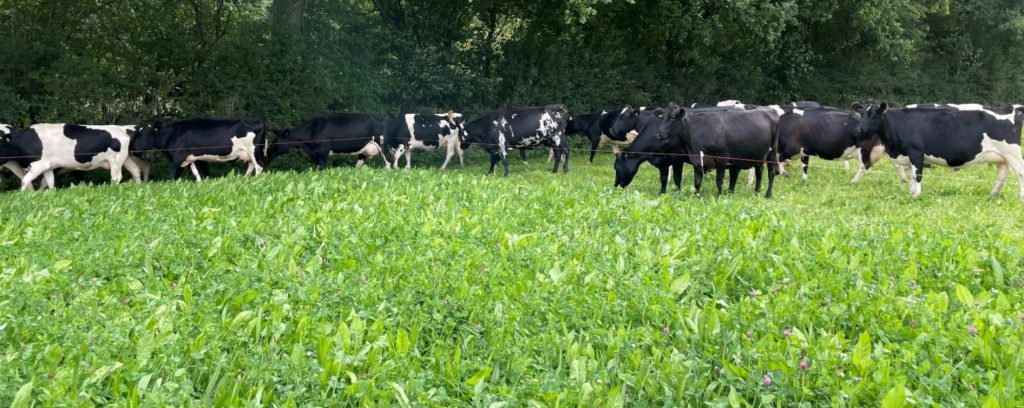
Overview of a Farm Net Zero event held on 22nd Oct 2022 at Lowerton Farm, Latchley.
John, Sue and Emma Nattle hosted a group of farmers on their dairy farm in the Tamar Valley to look at the establishment and management of herbal leys. The Nattle’s herd of 66 spring-calving cows produces 7000 litres a year from 1t of concentrate per cow. On the current herbal ley grazing, they are averaging 7 litres per cow.
Two blocks of herbal leys were established in 2020 and 2022, the older block (30 acres) is used for youngstock grazing and the second block (20 acres) is part of the dairy cow grazing platform. Brassicas (kale/rape) were included in the seed mix of both leys. This acted as a nurse crop, creating a microclimate that aided establishment of the herbs and grasses.
The older ley was established in April 2020 by overseeding the herbal ley mix into a combi-drilled barley cover. This was then cut for silage bales twice before being rotationally grazed by 35 youngstock until housing in November 2020. Rotational grazing with youngstock continued in 2021 and 2022, with any surplus cut for silage.

The dairy grazing ley was established in May 2022 by drilling herbal ley mix into a ploughed and power harrowed seedbed. From June 2022, it has been grazed by milking cows in a 42-day rotation “on/off” system where they are given access for three hours before being moved onto ryegrass/clover. This is to reduce bloat risk, overgrazing and compaction on the newly reseeded ground. The visit in October coincided with the third grazing round and, although regrowth was strong, this is likely to be the last grazing of the year to ensure sufficient covers are built for spring turnout.
Diversity has declined in the older block, with grasses and white clover more dominant. Although this could jeopardise any Countryside Stewardship GS4 payments, it is still a very productive ley. The newer ley showed a high level of diversity with plenty of chicory, plantain, white clover and red clover alongside a number of grasses.
Potential benefits of a diverse mixture of species include:
- Nitrogen fixation by legumes resulting in reduced (on cutting ground) or no (on grazing ground) need for purchased fertiliser
- Drought resilience from the deeper rooting species
- Improved soil health through enhanced soil biology, carbon sequestration and structure
- Reductions in leaching from greater root distribution through the soil profile and plants with different nutrient requirements through the growing season
- Extended grazing season
- Forage anthelmintics which complement prophylactic pharmaceutical treatments
- Improved resources for pollinators
Useful resources:
Part of the herbal leys established at Lowertown Farm were funded through the Farming in Protected Landscapes (FIPL) grant.
https://www.tamarvalley.org.uk/farming-in-protected-landscapes-in-the-tamar-valley-aonb/

This event was made possible with thanks to the National Lottery Community Fund who fund the Farm Net Zero project.


Recent Comments